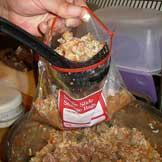
I recently ran across an article in Forbes magazine detailing a new dog food that uses hydrolyzed feather meal as a protein source. (Hydrolization is a process through which proteins are broken down into such tiny fragments that the immune system no longer recognizes and reacts to them.) The food in question is designed to help dogs with adverse reactions to traditional protein sources, a description that fits my dog Apollo. He has severe inflammatory bowel disease.
I don’t know much about feather meal, so I did a little research. Here’s what two industry publications (the only sources of detailed information I could find) have to say:
Hydrolyzed feather meal is a good source of natural protein for most animal diets. It can be used to replace a significant portion of other protein sources in livestock and aquaculture diets.
Many studies by university and private research scientists have confirmed the utilization of feather meal and the economic advantage as an ingredient.
American Proteins, Inc.
As costs for animal proteins increases and availability decreases, processed by-products have become an important primary protein source for the industry. Petfood manufacturers are forced to increase the usage of alternative, more economical feed ingredients.
Hydrolyzed, poultry-based proteins — eg hydrolyzed Feather Meal — are economically interesting protein sources used in specific areas of the feed business — like aquaculture. Usage of hydrolyzed Feather Meal in salmon feed is a case in point. These proteins are economically interesting and free of anti-nutritional factors. However, the use of (processed) Feather Meal in Petfood has been limited for reasons such as poor digestibility and issues related to marketing (ingredients declaration).
Unprocessed feathers are high in crude protein (90 percent), but highly indigestible due to the keratin structure, which contains high amounts of cross linked — disulphite bondings — cystine.
In order to open the S-S bonds and to make the crude feather available for digestive systems, feathers have to be processed.
Adding Value to Feathers
The Forbes article emphasizes the inclusion of hydrolyzed feather meal as a source of “hypoallergenic” protein, but it is my (albeit limited) understanding that any protein loses its allergenic properties after undergoing extensive hydrolysis. Based on the repeated references to the “economic” advantages of including feather meal in pet food mentioned above, I can’t help but feel that cost was a primary factor in the decision to use it in the food mentioned in the Forbes article, despite claims to the contrary.
I wonder whether the ingredient’s inclusion in a food designed for dogs with severe dietary intolerances is a type of test case. If Apollo would become unable to eat his current food, out of desperation I’d be willing to try one based on hydrolyzed feather meal, despite my general uneasiness about its use in dog food. After a number of client-owned dogs have eaten the food without deleterious effect, the company can then point to them as success stories, perhaps supporting the use of hydrolyzed feather meal in other products.
What do you think?

Dr. Jennifer Coates
Image: Arman Zhenikeyev / via Shutterstock









